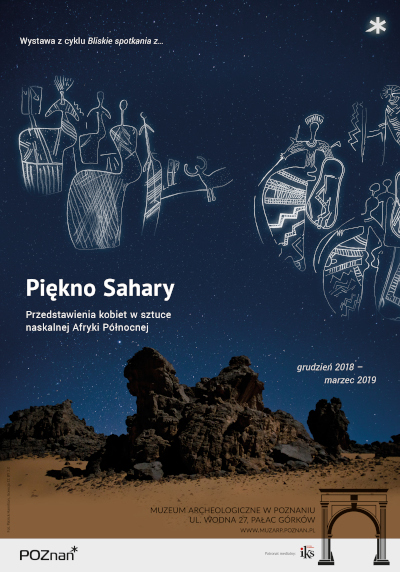Exhibitions
Departments
The exhibition of the cycle "Close encounters with..." dedicated usually to one artefact or a single topic.
December 2018 - January 2019
Exhibiton curator: Dr Paweł Polkowski
Although today the largest desert in the world, it is by no means an empty or monotonous land. On the contrary, the Sahara is an extraordinary wealth of landscapes and a world that we can still discover, both as travellers and as researchers. It is a real paradise for archaeologists because, despite the dangerous nature of the Sahara, people have been roaming and even inhabiting this land for thousands of years. Besides, now that we can reconstruct the climatic changes that have taken place over the last several-dozen thousand years, we know that the Sahara has not always been a desert. Around 12 000 years ago, with the beginning of the Holocene era, an influx of rain from the south gradually transformed the Sahara landscape into savannah and steppe. Over the next few millennia, it was much easier to find sources of water, as rivers flowed from the mountain ranges and lakes developed in the basins. For a large part of the Holocene  prehistory, people lived in completely different conditions than today, being able to hunt animals that today can only be found much further south.
prehistory, people lived in completely different conditions than today, being able to hunt animals that today can only be found much further south.
The remains of these communities are numerous, but some of them are particularly fascinating. These include the paintings and rock carvings, of which the Sahara has perhaps more than any other region in the world. They can be found almost anywhere on rocks, although the greatest accumulations of rock art are found on large plateaus and in the mountain ranges.
This exhibition highlights the stylistic and thematic diversity of prehistoric rock art in the area extending from Morocco to Egypt. On the other hand, it presents one particular theme or element in the rich repertoire of Saharan iconography - representations of women. We believe that the photographs and illustrations we have chosen offer a unique opportunity to look at women in African prehistory, as well as the art that depicts them. We would like them to provoke reflection both on the role of women in past societies and on the changing nature of aesthetic criteria, including the definition of beauty.
Paweł Polkowski
Nasza strona internetowa używa plików cookies (tzw. ciasteczka) w celach statystycznych, reklamowych oraz funkcjonalnych. Dzięki nim możemy indywidualnie dostosować stronę do twoich potrzeb. Każdy może zaakceptować pliki cookies albo ma możliwość wyłączenia ich w przeglądarce, dzięki czemu nie będą zbierane żadne informacje. Dowiedz się więcej jak je wyłączyć. OK, Rozumiem


